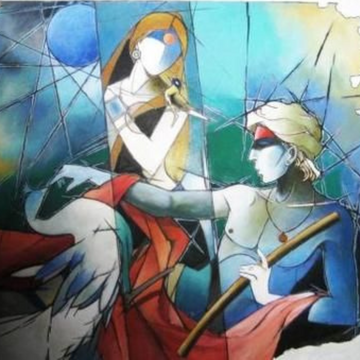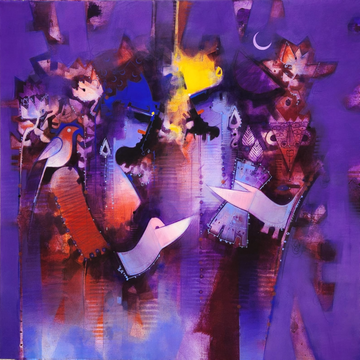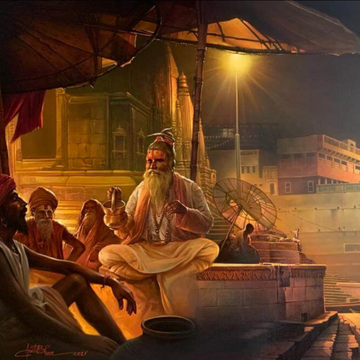Gautam Mukherjee- Exploring Family Ties with Indian Portraits

A tight hug to a sibling or an old friend, a gentle caress on your sleeping child’s forehead, a quick peck on their cheek and a hand on your lover/spouse’s shoulder, all display the same emotions; your love towards them. Your comfort and affection need not have words, your closeness would define your bond loud and clear and Gautam Mukherjee’s paintings revolve around this precise emotion.
George Bernard Shaw said, “A happy family is but an earlier heaven.” and Gautam Mukherjee’s paintings are nothing short of this heavenly feeling.

On a brightly coloured canvas, the artist paints portraits of different people. These people are dressed in traditional attire and flaunt a unique characteristic of Bengali people; the fish-shaped eyes. These paintings would remind one of the portraits of the royal and affluent families in the middle ages. However, instead of royalties they belong to commoners. Gautam Mukherjee emphasises on the emotions of his subjects, and his art leans towards stylised figurative form, rather than realism, a popular art form well liked for portraits.
Style and Subjects
The artist’s style has evolved over his career. He started off with an austere colour palette, however, the more he painted the more his style developed, and colours brightened. The vibrant tones now form an important part of Gautam’s paintings, they add a cheerful tone to these portraits. These paintings and the colours, reflect the vibrant and adventurous lives of Bengali people. Despite his colour combination and tones, Mukherjee has been loyal to his subjects. Over the years, a lot has changed in his technique and style, but one thing remained the same, his subjects. No matter which painting they choose, one will always see a strong bond the subjects share, with each other and with the artist, in these paintings.
Mukherjee says that he is a very sensitive artist, he is especially sensitive towards his subjects as they are based on the love and care of a family. His paintings carry the values and affection that his family shares, though the subjects in the paintings are not portraits of people from his family, they resonate with similar thoughts and traditions.

In a room full of strangers, one always develops a better friendship with the one sitting closer to them, and at social gathering, one always prefers sitting closer to their friends and acquaintances. In a way, the physical proximity between two people decides and shows the bond they share with each other. This is exactly what Gautam Mukherjee captures in his paintings.
“The strength and care in a bond between two people can be observed and judged by their physical closeness. I try to explore and express this distance between two people in my paintings,” the artist mentions, talking about his painting style. “People are always more comfortable with their family and friends and thus share a closer physical proximity with them, than with any other person.” There is nothing more innocent that a child hugging their parent, more beautiful than a wife getting ready for her husband and more romantic than a husband complimenting the beauty of his wife and Gautam, captures them all on his canvas.
The plaid or striped kurta with a neatly pleated white dhoti, portray a typical Bengali man. The women on other hand, are beautifully dressed in stunning long Bengali sarees with broad borders, gorgeous jewellery, the flowing or tied curly hair, the huge bindi and sindoor on their forehead and khol in their pretty fish-shaped eyes reflecting the perfect portrayal of a traditional Bengali women.

Old Havelis as Background
Apart from the subjects, Mukherjee pays a very special attention to his settings. The charm of old rustic Kolkata havelis is yet another common thread in his paintings. The wall colours, antique furniture, vintage window frames classic wooden toys, puppets, heirloom mirrors, work like stunning motifs in these paintings and point towards the simple lives lead by the modest Bengali people. With only one look at his paintings, onlookers can tell that they are inspired from traditional Bengali households. The artist’s “dhoung” or approach to his paintings involve including everything one might find in a typical Bengali home. The daily objects adoring these paintings such as the chairs, cupboard and mirror are homage to the vintage Bengali household items, but they are not photorealistic and neither are they the emphasis, they are only a detail in these paintings. They are the perfect setting to his subjects, who are combing their curly hair, looking out of the window or talking to someone over the phone.
But what really inspires his art? “Generations of family values,” the artist explains with a nostalgic smile on his face. “I was born and brought up in my ancestral home in Kolkata, which is 3 centuries old. Different generations of my family have lived in that house. Family values that were imbibed in me at a very early age, have influenced my art much beyond I could comprehend.”

Where did it all begin?
An art school cannot make a good artist, this is what Gautam Mukherjee believes. He thinks, apart from talent and art school one can foster their artistic skills in numerous ways. One can read about art, observe the paintings by other artists, interact with them, understand their thought process and their work discipline. But three things Mukherjee believes to be the most important to hone one’s skill are practice, practice and more practice and Gautam Mukherjee is the perfect person to emphasise on the importance of practising and improving on artistic talent, because he started that at a very young age.
He gives the credit for his love and talent for art to the annual festivities of Duraga Puja during his school days. He has painted and decorated the Puja marquee for as long as he can remember. The artist was extremely fascinated by “Kalighat Patchitra” an Indian art form which is embellished behind the Durga idol. “Ever since I saw it, I wanted to learn more about art”. Goddess Durga’s fish-shaped eyes, is also one of the most prominent features of Mukherjee’s portraits. He says that he was intrigued by the beauty of those eyes and wanted to replicate them in his paintings, after all, eyes are the most important features in human beings. Eyes are window to a person’s soul and Mukherjee believes, that the onlookers connects with the artist as they meet his subjects’ eyes.

Women as Subjects
Women are a very essential part of Mukherjee’s portraits and he accredits three most important women in his life for his inspiration. His mother who is not only his provider but also a friend who has always been there for him, his wife, who is also a painter and extremely supportive of the artist and his daughter, who brings him pure joy and gives meaning to his life. He says that they give him a home, a heart and encourage him and his work. The recent birth of his daughter, has nudged the artist to recreate the happiness and unconditional love that the child showers his/her family with.

Gautam Mukherjee’s colour palate is vibrant, his technique brilliant and theme simple. All he wants is to capture the simple joys and essence of life in his paintings. Just like his life, his art revolves around his family.













